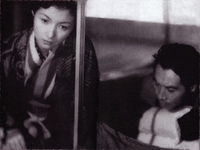On a bleak and cold morning in November 1946, a group of weary and destitute repatriates from Indochina, insufficiently dressed for the brisk northern weather, disembarks from a Japanese port with their meager belongings for an ill-planned and unassisted government resettlement after the war. Among the returning nationals is Yukiko (Hideko Takamine), a young woman who had traveled abroad to work as a typist for an expedition team stationed in Indochina by the Forest Ministry. Having initially left the country in order to escape the inappropriate conduct and violation of a morally reprehensible and opportunistic relative named Iba (Isao Yamagata), Yukiko is reluctant to return home and instead, visits the residence of an agricultural surveyor named Kengo Tomioka (Masayuki Mori), a former colleague from Indochina with whom she had a love affair. However, Yukiko’s longed for reunion with her lover is marked by disillusionment as the emotionally inscrutable Kengo is reluctant to rekindle their romantic relationship, explaining that his wife is ill and cannot leave her. Once ambitious and idealistic, Kengo now seems resigned and embittered, working in a string of odd jobs and a marginal enterprise on the sale of firewood. Nevertheless, Yukiko continues to persevere in the relationship despite Kengo’s half-hearted commitment, settling in a modest residence near the red-light district where she scrapes a meager existence as a euphemistic “hostess” for American servicemen, one of the few proliferating commerces under occupied Japan. But as Yukiko continues her pattern of self-sacrifice for her fickle and ungrateful lover, the prospect for rebuilding a life together in postwar Japan proves ever-increasingly untenable.
Based on a novel by Showa-era novelist and prose writer Fumiko Hayashi, Floating Clouds is a spare and understated, yet affecting portrait of melancholia, spiritual resignation, and unrequited longing. Mikio Naruse incorporates temporal nonlinearity through narrative ellipses and interwoven episodic flashbacks to create a sense of discontinuity that reflects Yukiko’s inconstant and moribund relationship with the callous and mercurial Kengo. Similarly, the film’s intrinsic visual economy and pervasive musical soundtrack – a languid, elegiac composition by Ichiro Saito – serve as a solemn accompaniment to, and innate reflections of, the couple’s transitory, emotionally detached, and aimless walks that further instill a somber, reinforcing leitmotif for Yukiko’s irredeemably doomed love affair: Yukiko’s initial visit to the Tomioka home, Kengo’s unannounced visit to Iba’s residence to borrow money, Kengo’s reluctant reunion with Yukiko at a seaside resort town. In the end, the sad and dispirited melody provides the funereal tempo to a reluctant, but inevitable ceremonial march: the unalterable course of a soul’s passage through the disillusionment and heartbreak of a cruel, hopeless, and unforgiving world in its elusive search for happiness.
© Acquarello 2003. All rights reserved.
